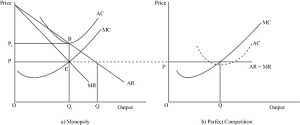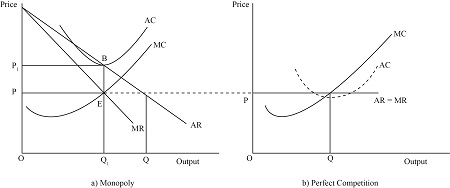Competitive Firm
In a perfectly competitive market, a firm faces the following conditions:
- Price (P): The price at which the firm sells its product is determined by the market. Because the firm is a price taker, it cannot influence the market price and must accept it.
- Marginal Revenue (MR): Marginal revenue is the additional revenue that the firm earns from selling one more unit of output. For a competitive firm, MR is equal to the price (P) because each additional unit sold increases revenue by exactly the price of the unit.
- Marginal Cost (MC): Marginal cost is the additional cost incurred by producing one more unit of output. The firm will continue to produce as long as the revenue from selling one more unit (MR) is greater than or equal to the cost of producing that unit (MC).
In a competitive market, the firm maximizes its profit by producing up to the point where:
\[ P = MR = MC \]
Here, the price (P) equals both marginal revenue (MR) and marginal cost (MC). This equality ensures that the firm is maximizing its profit. Producing more would increase costs more than revenue, while producing less would mean not making the most out of the potential revenue.
Monopoly Firm
In a monopoly market, a single firm controls the entire market. This firm faces the following conditions:
- Price (P): The monopoly firm can set its own price because it is the only provider of the good or service. However, it still faces the market demand curve, meaning it must lower the price to sell more units.
- Marginal Revenue (MR): For a monopoly, marginal revenue decreases as more units are sold. This is because, to sell additional units, the firm must lower the price on all units sold. Therefore, MR is less than the price (P).
- Marginal Cost (MC): Marginal cost is the additional cost of producing one more unit of output. Like in a competitive market, the firm will produce up to the point where MR equals MC to maximize profit.
In a monopoly, the profit-maximizing condition is:
\[ P > MR = MC \]
Here, the price (P) is greater than marginal revenue (MR), which equals marginal cost (MC). This occurs because the monopolist must lower the price to sell more units, meaning the additional revenue from selling one more unit (MR) is less than the price at which the unit is sold.
Key Differences
- Price Setting:
- Competitive Firm: Price is determined by the market (price taker).
- Monopoly Firm: Firm sets its own price (price maker).
- Marginal Revenue:
- Competitive Firm: MR equals the price (P).
- Monopoly Firm: MR is less than the price (P).
- Profit Maximization:
- Competitive Firm: Produces where P = MR = MC.
- Monopoly Firm: Produces where P > MR = MC.
Graphical Representation
Competitive Firm:
- The firm’s demand curve is perfectly elastic (horizontal) at the market price.
- The MR curve is the same as the demand curve.
- The firm maximizes profit where the MC curve intersects the MR curve.
Monopoly Firm:
- The demand curve is downward-sloping.
- The MR curve lies below the demand curve.
- The firm maximizes profit where the MC curve intersects the MR curve, but the price is read off the demand curve above this intersection.
 Understanding these differences helps in analyzing how market structures influence firm behavior, pricing strategies, and overall market outcomes.
Understanding these differences helps in analyzing how market structures influence firm behavior, pricing strategies, and overall market outcomes.

